| Defining servant leadership and the Healthy Organization |
| |
Servant Leadership is an understanding and practice of leadership that places the good of those led over the self-interest of the leader. Servant leadership promotes the valuing and development of people, the building of community, the practice of authenticity, the providing of leadership for the good of those led and the sharing of power and status for the common good of each individual, the total organization and those served by the organization. |
|
| |
The Healthy Organization is an organization in which the characteristics of servant leadership are displayed through the organizational culture and are valued and practice by the leadership and workforce. This is a healthy, servant organization. One that puts the needs of others first and through that gains incredible strength and power throughout the organization.
|
| Six Key Areas of a Healthy Organization |
| |
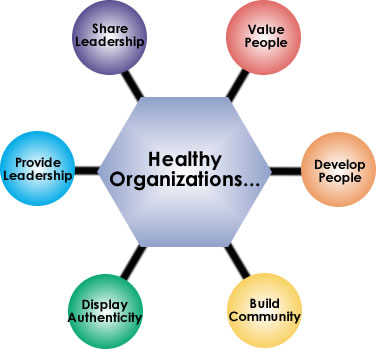
____________________________________________________________________________
|
| Display Authenticity |
| |
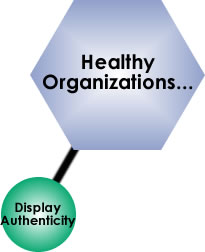 Healthy organizations have a different view of the leader. Leaders are to be open, real, approachable and accountable to others. They are not higher than others due to their “position.” In fact, position speaks to responsibility not value. As leaders work with people within organizations they will serve them by displaying the qualities of Authenticity. Healthy organizations have a different view of the leader. Leaders are to be open, real, approachable and accountable to others. They are not higher than others due to their “position.” In fact, position speaks to responsibility not value. As leaders work with people within organizations they will serve them by displaying the qualities of Authenticity.
Open & Accountable
Leaders will resist the tendency to protect themselves at all cost. When they make mistakes...they will admit them. They will recognize that they are accountable to others and not just those who are “over” them. People in a healthy organization can fully risk being open with each other due to the high levels of trust.
Willing to Learn
People in a healthy organization gladly accept the role of a learner. Leaders know that they have much to learn and that each person has something important to teach them. Leaders don’t always know what is needed andwhat to do. They are willing to listen before making suggestions. They ask questions...and are sincerely interested in the answers.
Honesty & Integrity
Healthy organizations refuse to cut corners on the truth. When they make a promise they do everything possible to fulfill it. People learn that they can trust what is said and that in this organization...the actions fit the words.
____________________________________________________________________________
|
| Value People |
| |
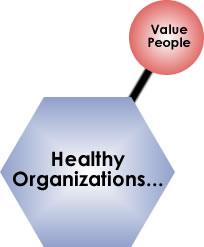 Healthy organizations have a different view of people. People are to be valued and developed, not used, for the purposes of the leader. Leaders accept the fact that people have present value not just future potential. People seem to have an innate ability to know whether or not they are being valued...whether or not they are trusted. Effective leaders accept a person’s value up front. They give them the gift of trust without requiring that they earn it first. As leaders work with people in organizations they will serve them by displaying the qualities of Valuing People. Healthy organizations have a different view of people. People are to be valued and developed, not used, for the purposes of the leader. Leaders accept the fact that people have present value not just future potential. People seem to have an innate ability to know whether or not they are being valued...whether or not they are trusted. Effective leaders accept a person’s value up front. They give them the gift of trust without requiring that they earn it first. As leaders work with people in organizations they will serve them by displaying the qualities of Valuing People.
Serve others first
People in healthy organizations put others before themselves. They focus on the needs of others and how they can best meet them.
Believe & Trust in people
Leaders are willing to give trust...to believe that others can do the job and have positive intentions. They work to envision the potential of people while looking beyond the immediate externals to find the true value others.
Listen receptively
When leaders truly listen to others they will hear them if they listen non-judgmentally. They listen to learn...to understand. They listen because they know that it is one of the best ways to show that they value others.
____________________________________________________________________________
|
| Develop People |
| |
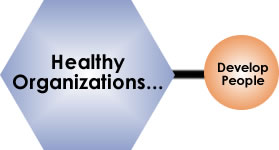 Healthy organizations have a different view of the potential of people. Leaders see it as their responsibility to help others grow towards their full potential as servants and leaders. Therefore, they seek to create a dynamic learning environment that encourages growth and development. The mistakes of others are seen as opportunities to learn. Leaders believe that people have both present value and future potential. Healthy leaders accept the responsibility of helping people realize that potential. As leaders work with people within organizations they will serve them if they display the qualities of Developing People. Healthy organizations have a different view of the potential of people. Leaders see it as their responsibility to help others grow towards their full potential as servants and leaders. Therefore, they seek to create a dynamic learning environment that encourages growth and development. The mistakes of others are seen as opportunities to learn. Leaders believe that people have both present value and future potential. Healthy leaders accept the responsibility of helping people realize that potential. As leaders work with people within organizations they will serve them if they display the qualities of Developing People.
Provide for learning
Healthy organizations offer people opportunities for new learning. They provide an atmosphere where mistakes can lead to new insights. Leaders join them in learning and are never satisfied with the status quo.
Model appropriate behavior
Leaders don’t just tell others what to do. They model it for them and do it with them. They help people to develop by working alongside them so that can learn from their example.
Build up through affirmation
Healthy organizations encourage others...honor others...accept others...build up others. They catch others doing it right. Leaders recognize accomplishments and celebrate creativity. They speak words of encouragement and intentionally affirm.
____________________________________________________________________________
|
| Build Community |
| |
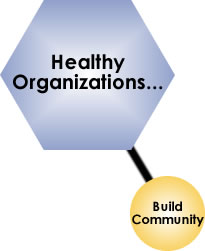 Healthy organizations have a different way of looking at how people work together. They desire to build community; a sense that all are part of a loving, caring team with a compelling shared vision to accomplish. They resist the tendency to “just get the job done” and are just as concerned with the relationships of the people doing the job. Leaders know that people will be more impacted by the quality of relationships than they will be by the accomplishment of tasks. Therefore they intentionally work to build a community that works together and learns to serve one other in the process. As leaders work with people within organizations they will serve them by displaying the qualities of Building Community. Healthy organizations have a different way of looking at how people work together. They desire to build community; a sense that all are part of a loving, caring team with a compelling shared vision to accomplish. They resist the tendency to “just get the job done” and are just as concerned with the relationships of the people doing the job. Leaders know that people will be more impacted by the quality of relationships than they will be by the accomplishment of tasks. Therefore they intentionally work to build a community that works together and learns to serve one other in the process. As leaders work with people within organizations they will serve them by displaying the qualities of Building Community.
Build relationships
Leaders and workers need the time and space to be together...to share, to listen, to reflect. They need to get to know one another. Healthy organizations don’t encourage lone-ranger success over team accomplishment. Instead, they encourage friendships to emerge.
Work collaboratively
Healthy organizations don’t allow the natural competitiveness between different individuals to characterize the atmosphere of the group. They don’t want to some to “win” at the expense of the Team. Leaders work alongside the others to model a dynamic partnership of collaborative work.
Value differences
Leaders respect and celebrate differences in ethnicity, gender, age and culture. They are aware of their own prejudices and biases. They confront these boldly so that no individual or group feels less valued or set apart from the team.
____________________________________________________________________________
|
| Provide Leadership |
| |
 Healthy organizations provide leadership for the good of those being led. Leadership is described as Initiative, Influence and Impact. Leaders do not neglect to take appropriate action, in fact, they have a bias for action. This initiative-taking comes not from being driven to personal ambition but by being called to serve the highest needs of others. Healthy organizations provide leadership for the good of those being led. Leadership is described as Initiative, Influence and Impact. Leaders do not neglect to take appropriate action, in fact, they have a bias for action. This initiative-taking comes not from being driven to personal ambition but by being called to serve the highest needs of others.
Envision the future
Healthy organizations are future oriented. They look ahead to envision what could be, and should be. The leaders recognize that they serve as partners with other leaders throughout the organization who also are looking ahead to the future. This organization shares their vision openly with the goal of creating a new and shared vision with others.
Take initiative
Leadership takes action. It doesn’t hold back in order to protect the leader from making mistakes. Leaders move out in order to serve others...and to serve the agreed upon mission of the organization.
Clarify goals
Healthy organizations are clear on where they are going. Leaders use clear and open communication to point the direction that the group is committed to pursue. The leader encourages accountability to the goals set...for themselves and for others.
____________________________________________________________________________
|
| Share Leadership |
| |
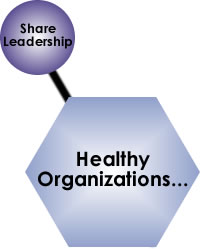 Healthy organizations recognize that every leader has power and must continually make choices as to how that power will be used. In these organizations the leader shares the power they have with others so that others can lead, thus increasing the potential influence and impact of the total organization. Healthy organizations recognize that every leader has power and must continually make choices as to how that power will be used. In these organizations the leader shares the power they have with others so that others can lead, thus increasing the potential influence and impact of the total organization.
Share the vision
Healthy organizations know that the vision of an organization does not belong to a single leader. A clear vision of the future, shared by the entire group, becomes a powerful magnet drawing together all of the resources, skills and abilities of the total team. Vision comes to leaders who see, and a shared vision occurs when the collective vision aligns toward a compelling and agreed upon future.
Share the power
Power has been described as the ability to do...to act. In organizational terms it represents the ability to make important decisions, allocate resources...moving people and projects forward to make things happen. Shared leadership empowers all people to act, for the good of the group and the mission of the organization.
Share the status
Leadership is not position, status or prestige. Leaders in healthy organizations resist the strong tendency to accept the special perks and privileges of leadership position. They know that all people throughout the organization need to be affirmed and recognized for their inherent value and for what they contribute to the success of the whole. | |